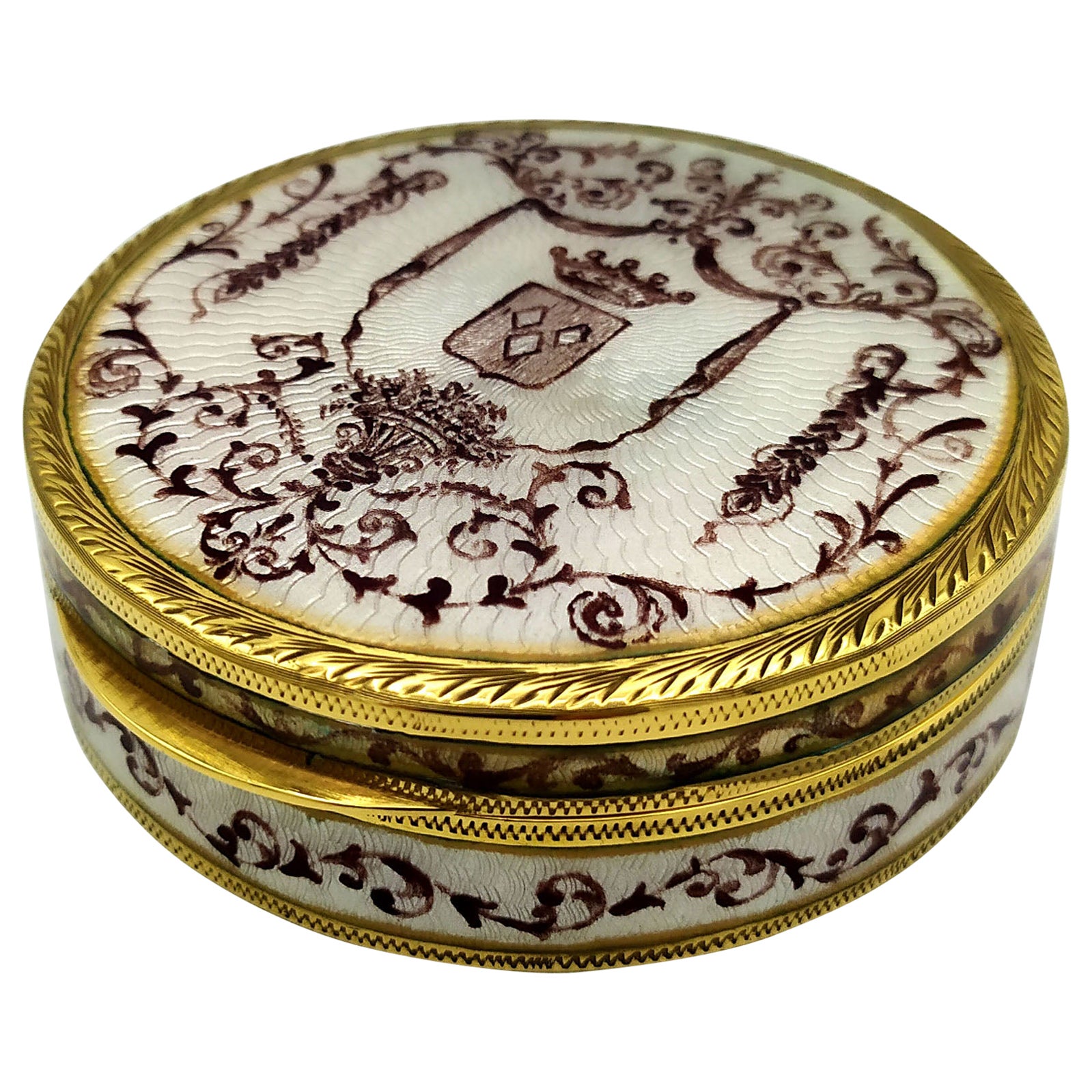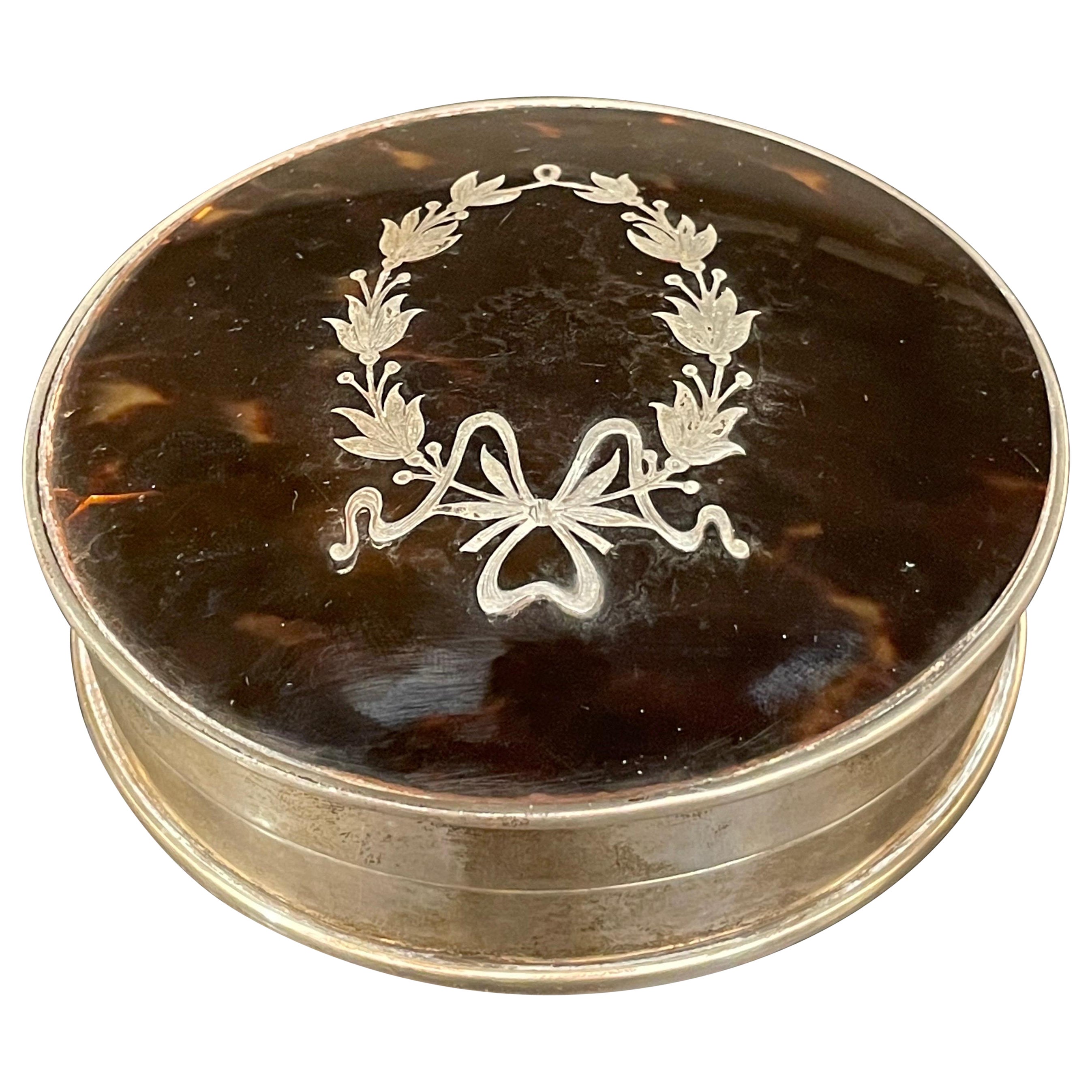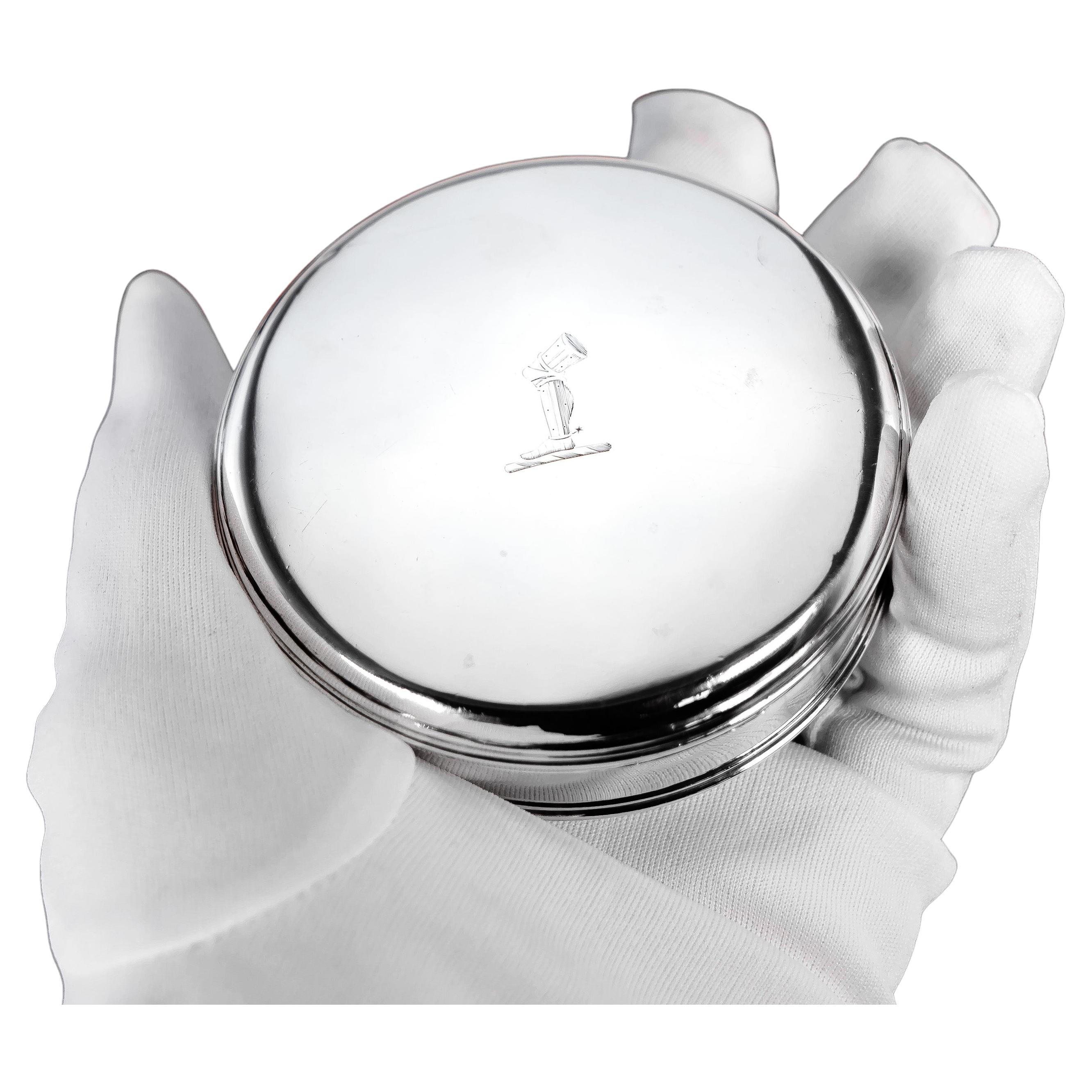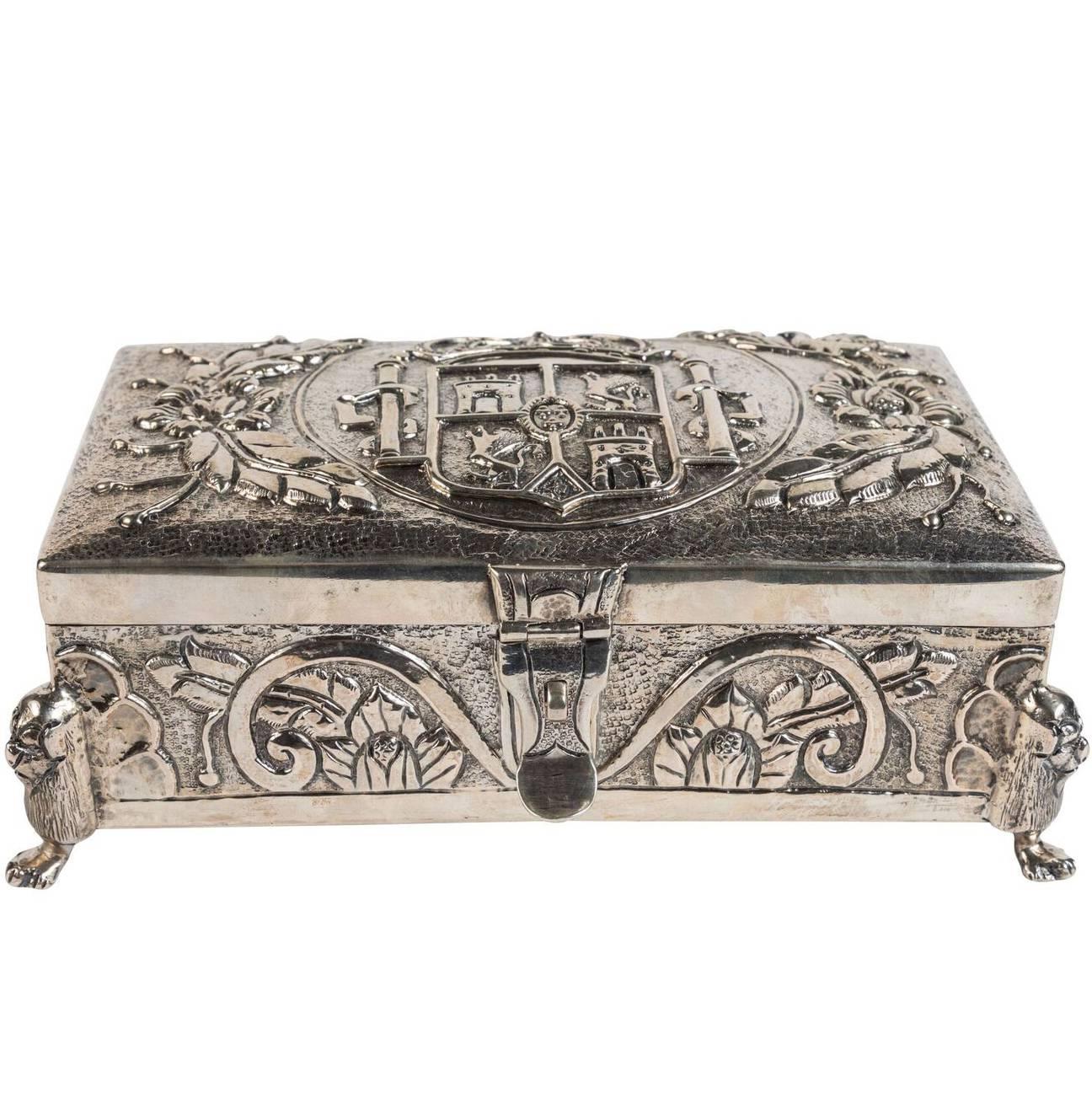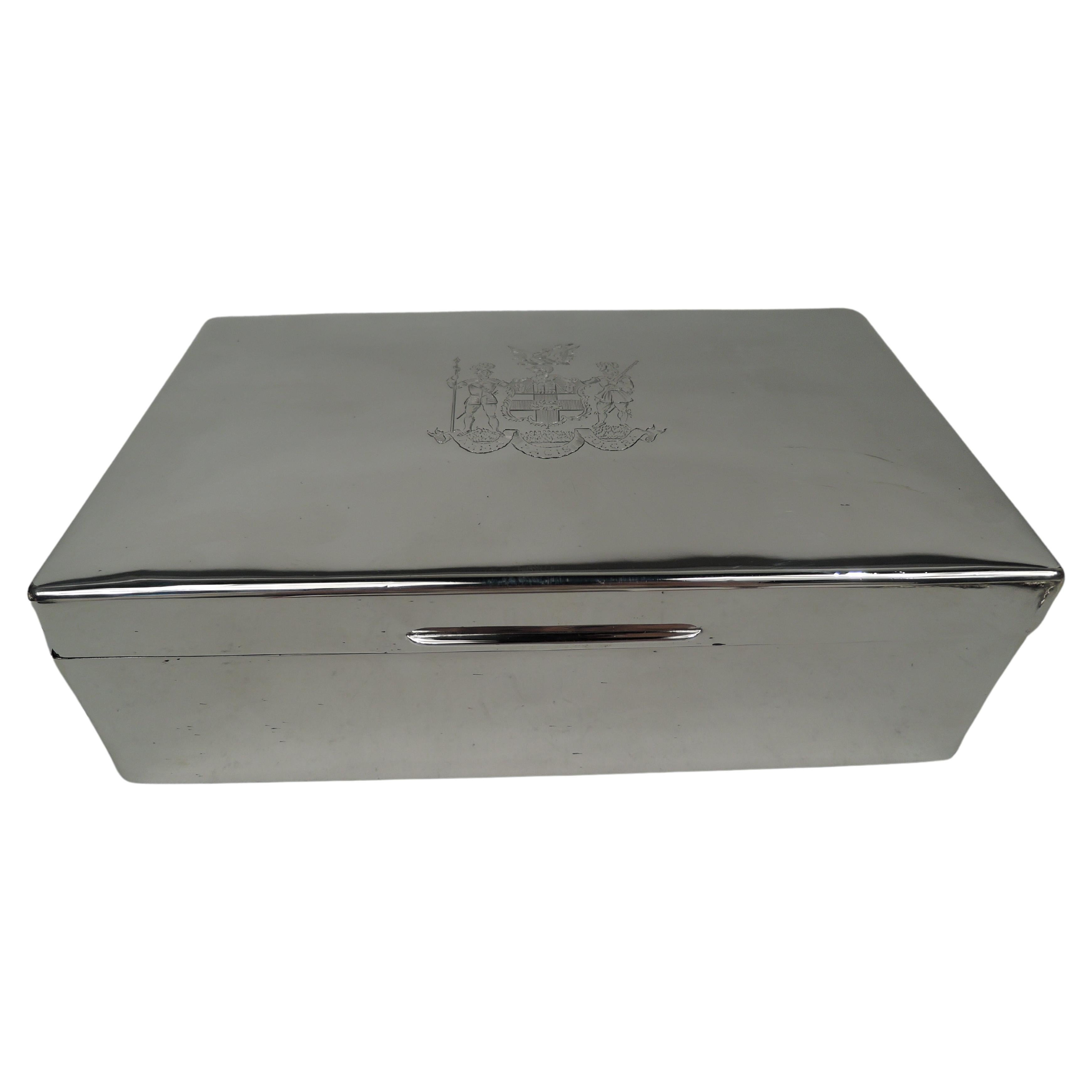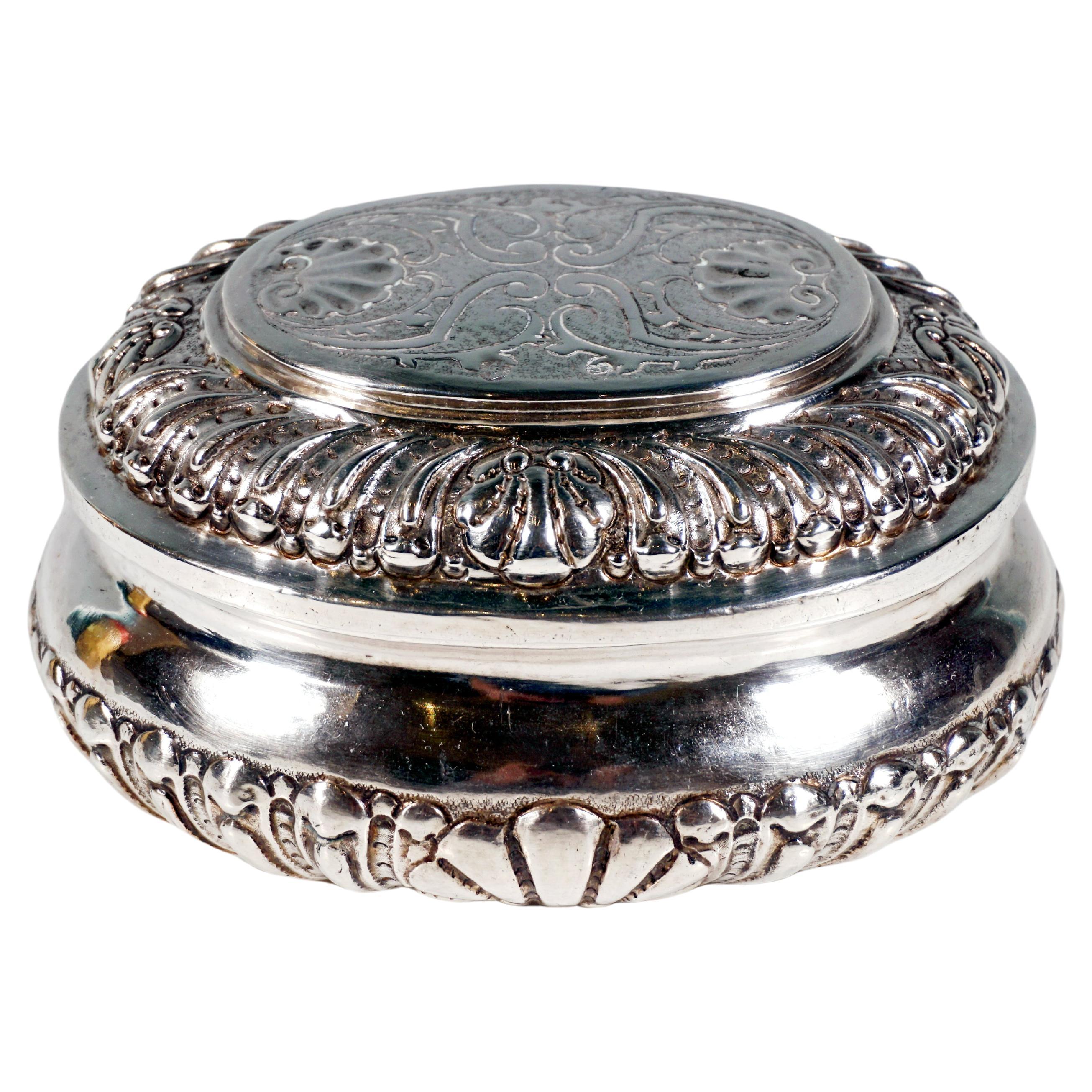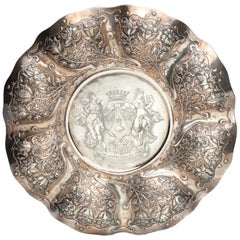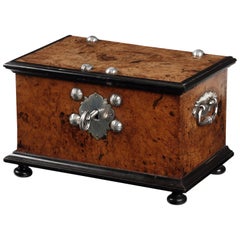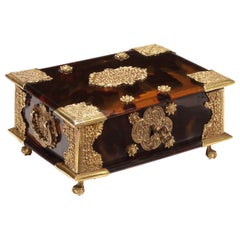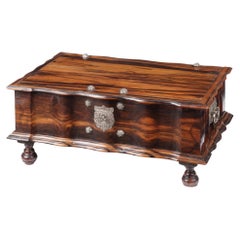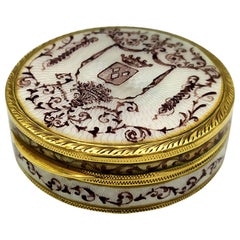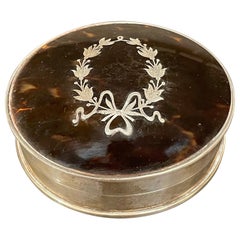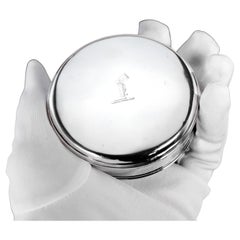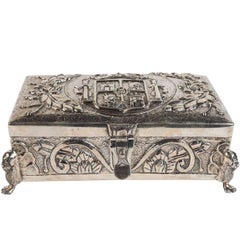Items Similar to Fine 17th Century Dutch Colonial Armorial Tortoiseshell & Silver Box, Dated 1691
Want more images or videos?
Request additional images or videos from the seller
1 of 3
Fine 17th Century Dutch Colonial Armorial Tortoiseshell & Silver Box, Dated 1691
$35,431.35
£26,549.13
€30,000
CA$49,749.51
A$54,523.95
CHF 28,473.45
MX$654,224.53
NOK 357,532.73
SEK 336,782.58
DKK 228,503.85
About the Item
A dutch tortoiseshell box with two engraved silver plaques
Amsterdam, 1691, with maker's mark of Steven des Rousseaux (1654-1733)
H. 5 cm
Diam. 12.5 cm
Note:
Steven des Rousseaux (Paris circa 1654 - Amsterdam 1733) in 1672 worked for the silversmith and assayer Roelof Hensbergen in Amsterdam. In 1681 he was registered as citizen of Amsterdam and silversmith. Des Rousseaux must have been prominent in the silver guild because in 1695 he was chosen headman of the silver guild and in 1710 he became member of the “Goede Mannen” who mediate in disputes between silver smiths and their clients. His maker’s mark is only on the silver plaque on the underside of the box, with the coat of arms of Costantijn Ranst (1635- 1714), suggesting that Ranst ordered the silver from des Rousseaux and had it made as a present to a member of the family whose coat of arms is engraved in the silver of the lid. The engraved coat of arms on the silver lid was initially thought to belong to the van Etten family from the small town of Etten-Leur in Brabant (see Uit Verre Streken, October 2016). However in 1691 that family was already long extinct in the male line. After additional research the coat of arms with the three castles can now be safely attributed to the Bijsterus family. Henricus Bijsterus, a Remonstrant clergyman, in 1670 became citizen of Amsterdam. His wife Hester Gravia (1635-1685) was the widow of Johan Hop, the brother of the powerful Grand Pensionary of Amsterdam Cornelis Hop (1620-1704).
In 1670 or 1671 Henricus and Hester had a son, Wilhelmus Bijsterus who later would have very close relations with Cornelis Hop. Cornelis would even become godfather to Wilhelmus’ son. Hester’s sister Catharina (1655-1735) was married to Isaac Ruts (1635-1712), member of a very rich and influential Amsterdam merchant family. After Hester’s death Henricus remarried Elsje Colijn (1634-1706), again a member of an important Amsterdam patrician family. Henricus died in 1688 so a few years before the box was made.
His son Wilhelmus studied at the Remonstant Seminary in Amsterdam. In 1694 he became burgher of Amsterdam and in 1701 Remonstrant clergyman, subsequently in Warmond, Delft and Amersfoort. He died in Leiden in 1749. In 1691, when the box was made, Wilhelmus was barely 20 years of age. Eventhough Constantijn Ranst was one of the richest men of Amsterdam why should he give a young man such a precious present? In 1691 Wilhelmus became a member of the Remonstrant Brotherhood of which Ranst already was a member and as such a good acquaintance of his father, the former Remonstrant clergyman in Amsterdam. Constantijn and Wilhelmus moved in the same Amsterdam circles and were almost neighbours, Ranst living on the Herengracht and Wilhelmus with his stepmother on the Keizersgracht. Another possible candidate is Lucas Bijsterus, born in 1651 or 1652 in Alkmaar.
In 1674 Lucas married Lijsbeth van Velsen, daughter of the bookprinter Jacob Samuelsz van Velsen in Amsterdam and till at least 1682 worked as a bookprinter and editor in Amsterdam. In 1692 Lucas, as a widower, turned up in Rotterdam where he married Neeltje Jacobsdr van Raemburgh. They had a son Simon who was baptized in the Remonstrant church in 1693. If Lucas left Amsterdam in 1691, could Ranst have given the box as a farewell present? We don’t know but personally I think Wilhelmus is the more likely candidate to have received the box from Ranst. However, family relationships can be traced but friendship relationships are much more difficult to trace. Constantijn Ranst, born in Amsterdam in 1635, signed up with the VOC and sailed to Batavia in 1659, making a stop at the Cape of Good Hope where he met Jan van Riebeeck who founded the Dutch settlement at the Cape.
In 1662 Ranst was sent to Deshima where he became Secunde for a year. From 1665 till 1667 he was “Opperhoofd” in Tonkin and in 1668 he was back in Deshima as “Opperhoofd”. From 1669 till 1673 he was Director of Bengal in Hugli. After his return to Batavia he was elected in the “Raad van Indië”. In 1677 he sailed back to Holland as Admiral of the return-fleet. He settled in Amsterdam where he bought Herengracht 527 and neighbouring 529, two very important canal houses, and he also bought seven warehouses on the Prinsengracht. In 1664 in Batavia he had married Hester Hartsinck, daughter of Carel Hartsinck, Director of Indië. A daughter born in 1671, called Hester like her mother, back in Holland married Jacob Hinlopen, one of the directors of the West Indiën Company. In 1717 Herengracht 257 was rented out to Tsar Peter the Great during his second visit to Holland, who apparently left it in a mess. Jacob Hinlopen inherited the house and until recently it housed the Geelvinck Hinlopen Museum. During the Dutch Golden Age Constantijn Ranst was one of the 250 richest men of the country and he owned a painting by Rembrandt “the adoration of the three Magi”.
- Dimensions:Height: 1.97 in (5 cm)Diameter: 4.93 in (12.5 cm)
- Materials and Techniques:
- Place of Origin:
- Period:
- Date of Manufacture:1691
- Condition:Wear consistent with age and use.
- Seller Location:Amsterdam, NL
- Reference Number:1stDibs: LU5458220973362
About the Seller
5.0
Recognized Seller
These prestigious sellers are industry leaders and represent the highest echelon for item quality and design.
Established in 1985
1stDibs seller since 2020
23 sales on 1stDibs
Typical response time: 18 hours
- ShippingRetrieving quote...Shipping from: Amsterdam, Netherlands
- Return Policy
Authenticity Guarantee
In the unlikely event there’s an issue with an item’s authenticity, contact us within 1 year for a full refund. DetailsMoney-Back Guarantee
If your item is not as described, is damaged in transit, or does not arrive, contact us within 7 days for a full refund. Details24-Hour Cancellation
You have a 24-hour grace period in which to reconsider your purchase, with no questions asked.Vetted Professional Sellers
Our world-class sellers must adhere to strict standards for service and quality, maintaining the integrity of our listings.Price-Match Guarantee
If you find that a seller listed the same item for a lower price elsewhere, we’ll match it.Trusted Global Delivery
Our best-in-class carrier network provides specialized shipping options worldwide, including custom delivery.More From This Seller
View AllDutch Colonial Silver Dish with the Von Pfeffel Coat-of-arms, 17th Century
Located in Amsterdam, NL
An unusual Indonesian lobbed silver dish
Jakarta (Batavia) or Coromandel coast, third quarter 17th century, apparently unmarked
The eight lobbed dish exuberantly decorated with floral motifs, with the middle section replaced, consisting of indistinctly marked German silver from the early 19th century, bearing the coat-of-arms of the Von Pfeffel family.
Diam. 30.5 cm
Weight 461 grams
Note:
Lobbed silver dishes with exuberant floral decorations were characteristic of the decorative arts in the Netherlands in the first half of the 17th century. This style of floral decoration was adopted by silversmiths as well as by furniture makers working on the Coromandel Coast and in Batavia, often by workers who had fled the Coromandel Coast because of war and famine. In Batavia this style was known as “Custwerck” (work from the Bengal coast).
These lobbed dishes are seldom marked. Only after 1667 the use of the town mark became obligatory in Batavia but only for silver made in Batavia not for silver imported in Batavia from other VOC settlements. The engraved coat of arms in the centre is a replacement of the original centre.
The coat of arms can be identified as those of Christian Hubert von Pfeffel (1765- 1834). As a diplomat, statesman, ambassador of Bavaria in London and Saxony and councillor to the King of Bavaria, he was made “Freiherr” in 1828 and since then used this coat of arms. His son Karl Maximilian Friederich Hubert Freiherr von Pfeffel (1811-1890) in 1836 married Karoline Adelheid Pauline von Rottenburg (1805-1872), the natural daughter of Prins Paul von Württemberg (1785-1852) and his mistress Margrethe Porth. Paul was the jounger brother of the King Wilhelm I of Württemberg (1781-1864). The heraldic motto of the von Pfeffels Vur Schande habe den Huot means as much as “Beware of Shame”. Christian Hubert Theodoor Marie Karl von Pfeffel Karl Maximilian’s grandson was the last male in the von Pfeffel line. His daughter, Marie Louise (Paris in 1882 - Cornwall 1944), born and grown-up in France, changed her name in de Pfeffel. She was the great grandmother of Boris Alexander de Pfeffel Johnson, the present British Secretary of State. None of the members of the von Pfeffel family had any direct links with the Dutch East Indies but indirectly by way of the Royal House of Württemberg they did.
Sophia Frederika Mathilda von Württemberg (1818-1877), daughter of Wilhelm I King of Württemberg, in 1839 married Willem III...
Category
Antique Late 17th Century Indonesian Dutch Colonial Sterling Silver
Materials
Silver
Fine Dutch Colonial Indonesian Casket with Silver Mounts, circa 1706
Located in Amsterdam, NL
A fine Indonesian Ambonya burl, ebony and teak casket with silver mounts
Jakarta (Batavia), circa 1706 (year letter W (1705-1710), marked DV, probably Dirck Vooght
The outer ri...
Category
Antique Early 18th Century Indonesian Dutch Colonial Decorative Boxes
Materials
Sterling Silver
A small Dutch colonial Indonesian tortoiseshell betel box with gold mounts
Located in Amsterdam, NL
Jakarta (Batavia), 18th century, apparently unmarked
L. 14 x W. 9.5 x H. 4.7 cm
Before settling down to business in the former Dutch East Indies, sirih had to be offered in the mos...
Category
Antique Late 18th Century Indonesian Dutch Colonial Antiquities
Materials
Gold
Dutch-Colonial Sri Lankan Coromandel Wood Document Box with Silver Mounts
Located in Amsterdam, NL
A Dutch-colonial Sri Lankan coromandel wood document box with silver mounts
Probably Galle, 18th century
H. 19 x W. 49 x D. 33 cm
The ches...
Category
Antique 18th Century Sri Lankan Dutch Colonial Furniture
Materials
Silver
A highly refined Dutch-colonial Sri Lankan inlaid box with silver mounts
Located in Amsterdam, NL
Galle district, 18th century
The box is made of amboyna burr with inlays of ebony, bone and burr wood and has several interior compartments, all made with the utmost attention to de...
Category
Antique 18th Century Sri Lankan Decorative Boxes
Materials
Bone, Ebony, Amboyna
A colonial tortoiseshell veneered casket with silver mounts
Located in Amsterdam, NL
Possibly Spanish colonial, 17th century
H. 15.2 x W. 25.1 x D. 12 cm
Included is a hand-written letter, reading:
Ik Ondergetekenden verklare bij dezen, dat mijn Wel en Begeerte is...
Category
Antique 17th Century Mexican Antiquities
Materials
Silver
You May Also Like
Snuff Box White with noble coat of arms Baroque style Sterling Silver Salimbeni
By Giorgio Salimbeni, Salimbeni
Located in Firenze, FI
Snuff Box noble coat of arms is in 925/1000 sterling silver.
Snuff Box noble coat of arms has White fired enamels on guilloché and handpainted miniature of arabesques with noble coat...
Category
1990s Italian Baroque Snuff Boxes and Tobacco Boxes
Materials
Sterling Silver, Enamel
Antique Edward Souter Barnsley & Co. Sterling Silver & Tortoiseshell Powder Box
Located in Atlanta, GA
An 1894 antique Edward Souter Barnsley & Co. sterling silver and tortoiseshell powder box decorated with a silver laurel leaf and bow inset to...
Category
Antique 19th Century Decorative Boxes
Materials
Sterling Silver
$1,000 Sale Price
20% Off
Antique Georgian Silver Large Tobacco Box with Crest - James Phipps I c.1770
Located in London, GB
We are delighted to offer this wonderful Georgian solid silver tobacco/snuff box with the marks of James Phipps I (London) c.1770.
This silver circular box is made with superb pro...
Category
Antique 18th Century Sterling Silver
Materials
Silver
19th Century, Silver Plated Box with Royal Crest
Located in Los Angeles, CA
Dramatic, richly embellished, silver-plated, hinge-top box featuring the ancient Coat of Arms for the Spanish kingdom of Castile and Leon. The whole atop lion-form feet.
Category
Antique 1890s Spanish Decorative Boxes
Materials
Silver Plate, Metal
Comyns Sterling Silver Box with British Army Regimental Coat of Arms
By Richard Comyns
Located in New York, NY
George V sterling silver box. Made by Richard Comyns in London in 1934. Rectangular with straight sides and curved corners. Cover hinged with gently curved top and tapering tab. On c...
Category
Vintage 1930s English Edwardian Decorative Boxes
Materials
Sterling Silver
Antique Vienna Baroque Silver Sugar Box, by Zacharias Fayll, 1705/1715
By Viennese Manufactory
Located in Vienna, AT
Baroque silver box with loose plug-in lid in a bulbous oval shape, flush stand without feet, in the lower area of the container and on the lid chased boss decoration with ornamentati...
Category
Antique 1710s Austrian Baroque Sterling Silver
Materials
Silver
More Ways To Browse
Engraved Shell
Antique Messer
Cape Of Good Hope
Antique Tortoise Shell Glasses
17th Century Adoration Of The Magi
Tortoiseshell Sterling
Georg Jensen Pyramid Spoon
Antique Furniture Edinburgh
Antique Potato
Antique Sterling Wine Coaster
Colonial Silver Spanish
English Sterling Silver Salvers
Lily Of The Valley Sterling
Paul Revere
Sheffield England Silver Serving Spoon
18th Century Spoons
Antique 800 German Silver
Antique Pie Servers
